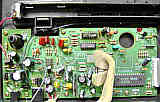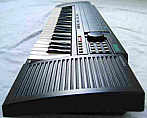YAMAHA |
(sample based keyboard with nice demos) |
This sample based stereo keyboard from 1992 is nothing really great
and behaves unpleasantly stubborn and unflexible, but it has many nice
demo musics and clear sounds.
Although it has in total 100 preset sounds, many of these are simply variations
of other with additional echo or sustain or key split sound combinations.
All sounds are medium resolution samples of mainly acoustic instruments
those sound very establishment and contain nothing avantgardistic or tekkno-
like. The 50 preset rhythms have an accompaniment that accepts only standard
chords. Despite there are 4 drumpads those can be switched between 4 drum
sets, it has no programmable rhythm and even their select buttons (and
all others) make a disturbing noise that prevents reasonable live play
on them. Beside the normal rhythms there are 20 so- called "jam tracks"
(like demos without melody voice), those play pre- programmed chord sequences
and automatically switch the main voice sound all few patterns.
This keyboard and its shorter relatives PSS-21 and PSS-11
have been emulated on MAME.
main features:
-
49 midsize keys
-
2 built-in speakers (reasonable quality, stereo)
-
polyphony up to 12 notes (including rhythm, accompaniment etc.)
-
100 preset sounds:
-
only 40 normal sounds
-
16 layered sounds ("dual voice")
-
11 key split combinations
-
5 with sustain
-
13 "harmony voices" (employ duo, trio effect etc., only monophonic playable)
-
15 with echo effect
-
50 preset rhythms
-
20 preset "jam track" rhythms {dance, rap, funk, soul ballad, minor blues,
heavy metal, boogie woogie, rock 'n' roll, r&b, slow rock, jazz blues,
jazz waltz, fusion, bossa nova, samba, tango, ska, country, march, new
age}
-
preset sounds, rhythms, jam tracks & demos selected by 10 cipher buttons
or +/- buttons and "music mode selector" knob {power off, style, voice,
song}
-
combined single finger & fingered accompaniment (only standard chords)
-
volume +/- buttons (16 steps)
-
tempo +/- buttons (51 steps)
-
4 drumpads with 4 drum sets {base, snare, closed hihat, open hihat | crash
cymbal, low tom, mid tom, high tom | tekkno base, snare, closed high hihat,
open high hihat | closed hihat, low synth tom, mid synth tom, high synth
tom}
-
"AWM" wavetable sound generator with sounds based on medium resolution
samples with partly complex volume envelopes (those e.g. simulate echo)
and high sound quality (16 bit?, crystal clocked).
-
multi-chip hardware:
-
CPU= "Yamaha YMW270-F, 9224 AEFB" (80 pin SMD | GEW7)
-
ROM= "©1992 Yamaha, XL437CO" (XL437A00) (32 pin DIL, 256KB)
-
20 lovely demo melodies (wonderful complex polyphonic orchestrations)
-
"minus one" function (mutes melody voice of demos to train playing)
-
jacks for AC- adapter & headphones/ line out

eastereggs:
-
service mode: Hold the 2 leftmost white keys during power-on to
run the test program. A piano chord will sound. All keys play "e. organ"
notes without vibrato (which is no preset sound). All panel buttons, drumpads
and even the "music mode selector" knob (when turned) play sine wave notes.
The volume always stays at maximum.
-
echo speed controllable by tempo button.
-
To select only the fingered chord mode, press "0" during power on; press
"1" instead for single finger mode (explained in the manual)
notes:
Very annoying is that Yamaha divided the preset sounds into groups
with or without sustain, echo, key split etc. with only quite few sounds
per group. Why didn't they instead add separate OBS effect buttons (or
at least effect function numbers or similar) to let the user decide to
add such effects to any preset you want (and not just offering 5 fixed
preset sounds with sustain)?! (The same nonsense exists on Yamaha
PSS-16.) In early 1980th it was a matter of course to combine any
preset sounds with any given effects. (Where hardware restrictions prevent
it, the effect selection should be simply ignored.) All button presses
and even turning the "music mode selector" knob play a high or low bongo
noise, which disturbs live play. Sound and hardware of this instrument
have many similarities with the small Yamaha
PSS-6. (I haven't examined the hardware closer yet.)
The main voice sounds of this instrument are based on medium resolution
samples those sound clean, quite cold and static, but not noisy or lo-fi.
Unfortunately they are strictly focussed on natural instrument samples
those sound very establishment and just like expected. The only exception
are the 2 "brass ens.", those sound rather like a harsh and hollow human
"ah" voice (or "vox humana" pipe organ rank?). There are no remotely extreme
synth or dedicated tekkno sounds. Nice for tekkno may be only the "tenor
sax" sample, which wind noise of the attack phase turns into a low hissing
noise, followed by the sonorous woody bass tone. Also the "orchestra hit"
is a famous early 1990th tekkno effect (turns very grainy when pitches
down). The "fantasy 1" sounds like a vibraphone layered with a delayed
flute, while "fantasy 2" resembles a woodwind/ flute ensemble timbre
with decay envelope and sustain. There is also a drum kit mode (with and
without echo), that mainly consists of acoustic drums, but also features
a knocking tekkno base and 3 synth toms. The preset sounds of the "harmony
voice" group play a fixed duet, trio or other chord, they are nice for
soft pad timbres but can be only played monophonic; at least they recognize
in which key you play in single finger chord mode.
(The full sound & rhythm list can be found in the manual of this
instrument, downloadable on the Yamaha
Manual Library site.)
The accompaniments sound good and employ a lot of different sounds,
but they behave very static. Unusual is that it recognizes fingered and
single finger chords simultaneously, but only standard establishment chords
can be played, and unlike e.g. the great Yamaha
PSS-390, there are neither fill- ins nor intro/ ending features
(the rhythms end with a loud crash cymbal) and nothing is programmable.
The rhythm preset 49 "bass chord hold" is no rhythm but the manual chord
mode (plays a string chord with e-bass on the first held note). Like with
most modern Yamaha keyboards, the style bank is mainly centered
on the jazz, funk, fusion and soul environment.
The rhythms use medium resolution samples of acoustic percussion. The
rhythm tempo can be set quite low but only medium high. To select a rhythm,
turn the "music mode selector" knob on "style" and enter its number, which
also always selects a default preset sound corresponding to it. If you
want to play with accompaniment, just press a key in the accompaniment
section to start it (behaves like synchro start). If you instead want to
play without, press "start/ stop" to start the rhythm and set the knob
back to "voice" to switch the left keyboard section back to melody play.
When the accompaniment is already running, the turn of the knob won't stop
it (otherwise you would be incapable to select a preset sound with accompaniment
on), thus you have to press "start/ stop" 2 times to stop and restart the
rhythm without accompaniment, which is quite confusing.
 I
don't know what
Yamaha intended with this stupid user interface,
but intuitive is something different. At least you can step through sounds
and rhythms with +/- buttons, but this instrument gives absolutely no visual
feedback (not a single LED). The shape of the cipher button keypad with
its black knob reminds to an early electronic safe lock, and almost feels
as cryptic as opening a safe by stethoscope, which is certainly nothing
you want to do during live play. (Remember, each button or knob operation
plays here a bongo noise.) Annoying is also that there are no separate
rhythm and accompaniment volume controls. I
don't know what
Yamaha intended with this stupid user interface,
but intuitive is something different. At least you can step through sounds
and rhythms with +/- buttons, but this instrument gives absolutely no visual
feedback (not a single LED). The shape of the cipher button keypad with
its black knob reminds to an early electronic safe lock, and almost feels
as cryptic as opening a safe by stethoscope, which is certainly nothing
you want to do during live play. (Remember, each button or knob operation
plays here a bongo noise.) Annoying is also that there are no separate
rhythm and accompaniment volume controls. |
There are 20 additional special accompaniments called "jam tracks",
those play a pre- programmed chord sequence (like a demo without melody
voice) and also automatically select and switch the main voice preset sound
so far the knob stays set to "song"; setting it to "voice" disables this
behaviour and permits manual preset sound selection.
The instrument has a song bank of 20 wonderful orchestrated polyphonic
demo melodies:
-
Original Song 1 [great funk tune]
-
Original Song 2 [latin fusion]
-
Original Song 3 [slow latin fusion]
-
House of the Rising Sun
-
The Last Rose of Summer
-
Sur Le Pont d'Avignon
-
Waltz of the Flowers
-
Air on the G String
-
Beautiful Dreamer
-
Londonderry Air
-
Symphony No. 40
-
Deck the Halls
-
Auld Lang Syne
-
Silent Night
-
Tannenbaum
-
La Cucaracha
-
Oh! Susanna
-
Song of Joy
-
O. Vrenelli
When a selected demo is started with "start/ stop" or any key instead of
the "demo" button, the main voice is muted, thus the player can improvise
to the demos. All demos are quite long and complex arranged. The 3 "Original
Song" pieces are jazzy funk/ fusion musics; these are different from Yamaha
PSS-6. Particularly "Original Song 1" is a nice groovy funk tune.
"Deck the Halls", "Londonderry Air", "Symphony #40" are in a dreamy blues/
jazz style that sounds very mellow and muzak-like. Apparently Japanese
like such stuff, because I also found it in Japanese videogame highscore
musics and anime movies.
Shorter variants of the PSS-31 are the Yamaha PSS-21 (stereo,
37 midsize keys) and Yamaha PSS-11 (mono, 32 midsize keys, no drumpads);
both have only 25 rhythms, 15 demos and 15 jam tracks and accept no fingered
chords (explained in the manual). Service manual photos reveal that all
these have the same "ROM 2M" (256KB) part number "XL437A00", thus all missing
PSS-31 features in these instruments can be likely added as eastereggs
by installing a fixed keyboard matrix diode somewhere. A fullsize PSS-31
version without drumpads is the PSR-75.
A more advanced fullsize variant is the Yamaha PSR-110 (49 keys,
stereo), which can assign to its drumpad buttons 4 additional effect sample
combinations (animal voices etc.), but it has a 512KB ROM (part no. XM041A00).
Another stereo variant is the PSR-150 (61 keys, separate effect pads, different
512KB ROM XL561A00). The same preset sound and rhythm set is also used
by Yamaha PSR-73/ PSR-74/ PSR-125 (1 speaker) and PSR-76/PSR-77
(2 speakers mono), those have LED display, no drumpads, no knob and the
newer CPU "YMW282-F" (GEW7S) with 512KB ROM "KM23V40008-KP5203B" (XP686A00).
This sound engine was quite successful; even in 2003(?) the cheapest Yamaha
fullsize
keyboard without MIDI/ velocity (PSR-125 ?, seen in shopping center)
still had the sound set of PSS-31. (Main ICs checked by schematics photos;
I don't own any of these.)
| removal
of these screws voids warranty... |
|
|
 |

|
|
| |
back
|
|



